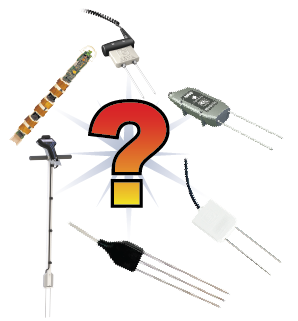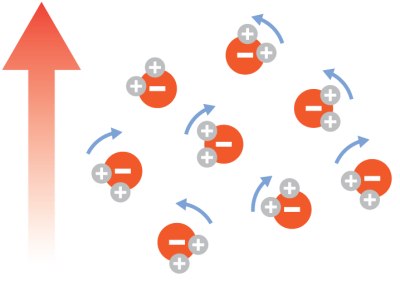How To Find Volumetric Water Content Of Soil

Because there are many different types of soil h2o content sensors bachelor, choosing the best ane for your awarding may seem difficult or even confusing. To help you make your choice, information technology'southward important to understand what soil h2o content sensors actually measure out, what makes a skillful soil h2o content sensor, and how to make sense of the manufacturer specifications. In this article, I'll encompass these topics to help you with your sensor selection procedure.
What do soil water content sensors really measure?
You lot may notice it surprising that there are no commercially bachelor soil water content sensors that measure h2o directly. Instead, what the sensors do is discover changes in some other soil property that is related to water content in a anticipated way. Common soil backdrop that modify with h2o content and are like shooting fish in a barrel to measure out include dielectric permittivity, thermal conductivity, and density of neutron flux. This article focuses on sensors that measure dielectric permittivity.
Dielectric permittivity sensors are the almost mutual type of soil water content sensor on the market. These sensors use different technologies to mensurate the permittivity of the surrounding soil, including the following:
- Fourth dimension domain reflectometry
- Time domain transmissivity
- Frequency domain reflectometry
- Time of charge capacitance
- Transmission line oscillation
- Coaxial impedance dielectric reflectometry
- Coaxial differential amplitude reflectometry
Regardless of the technology, the same principle is used: the bulk dielectric permittivity of soil changes with volumetric water content.
The simplest fashion to think of permittivity is as stored electric free energy. The sensor generates an electric field in the soil and, because the water molecule is polar, unbound h2o molecules in the soil rotate to line up with the electric field lines.

That rotation of unbound water molecules requires energy, which is stored equally potential free energy in the aligned water molecules. The more water there is in the soil, the more than energy gets stored, and the higher the bulk permittivity of the soil.
The other constituents of soil—mineral and organic solids, and air—store electric energy too, but water tin can store more than ten times as much as the other parts of soil. Because of that, h2o movement in and out of the sensor's measurement volume is the major contributor to changes in permittivity.
The soil water content sensor is designed to have an electrical signal that changes with permittivity and, therefore, with h2o content. Some sensors determine permittivity and then convert that to water content, while others convert the sensor's electrical output to volumetric h2o content in a unmarried step. No matter which method is used, the water in the soil affects the majority dielectric permittivity, which affects the sensor's electrical output. This is important to remember when you are comparing accurateness specifications.
What makes a good soil water content sensor?
An ideal high-performance soil water content sensor has all of the following properties:
- It meets your requirements for accuracy and resolution.
- It lasts as long as you need it to.
- Information technology requires minimal scale and does not require recalibration.
- It meets your budget requirements.
- It is easy for you to install and measure.
As yous might imagine, these properties tin can be in competition with one another. For instance, a durable, high-accuracy sensor may be more expensive when compared with a less durable sensor with lower accurateness. Sensor manufacturers effort to detect the correct balance between these competing factors. To decide which sensor is best for your application, make up one's mind which of these factors are most important to you lot, and and then look for the sensor that best matches your highest priorities.
What do the manufacturer specifications mean?
To really sympathize the specifications for soil water content sensors, it is helpful to think nigh the human relationship between water content, dielectric permittivity, and the electric signal that varies with permittivity. The relationship betwixt those three things will determine the accuracy and resolution of the water content value and the operational range of the sensor.
Accuracy
The accuracy of the volumetric water content measurement depends on several things:
- The accurateness of the electric measurement
- Temperature effects on the measurement electronics
- Temperature effects on the permittivity of water and the soil electric conductivity
- The sensor's accuracy in estimating unlike values of dielectric permittivity
- The accuracy of the office that converts the electrical measurement or the permittivity value to volumetric h2o content
- The extent to which the soil around the sensor matches the calibration function
If all soil water content sensors provided an accuracy specification for measuring permittivity, we'd have a much easier time comparing the functioning of different sensors. Unfortunately, many users practice not fully sympathise the relationship betwixt permittivity and volumetric h2o content, and the unlike conditions that can add error to the final guess of water content.
Considering there is no unmarried calibration function that volition work for all soils, manufacturers usually select ane or a few "representative" soils and provide a h2o content accuracy specification based on that selection. So, for example, what does an accurateness specification such as "±1% volumetric water content" really hateful? This specification means ±1% under the conditions where the calibration piece of work took place. Those conditions were likely indoors with minimal temperature variation and merely 1 or a few representative soil types.
- If your environs has those same weather, the sensor accuracy will meet the specification.
- When you lot accept the sensor out in the natural environment—where there is much more variation—its accuracy may not meet the specification unless yous perform your own scale.
Another important consideration is that the accuracy of dielectric soil water content sensors decreases as the soil gets very dry. When the corporeality of h2o in the soil is very low, its contribution to the overall bulk permittivity of the soil is smaller and may drop below the sensor'southward power to detect changes. In dry soil, temperature often affects the sensor output more changes in h2o content.
Tip: Be very cautious with specifications that hope loftier accurateness at low water content levels.
Note: Accuracy may be specified every bit absolute accurateness (% water/% dry soil) or as percentage of reading. To convert per centum of reading to absolute accurateness, multiply by the upper and lower limits of the operational range.
For example: Campbell Scientific'south CS655 accuracy specification for dielectric permittivity in the soil range is ±(iii% of reading + 0.8) from one to twoscore for solution electrical conductivity ≤ 8 dS/m. If the sensor permittivity reads i (in air), the accuracy of that reading is ±(one x 0.03 + 0.viii) = ±0.83. If the sensor permittivity reads forty, the accuracy of that reading is ±(xl x 0.03 + 0.viii) = ±2.
A final discussion about accuracy: Manufacturers write their specifications to cover a wider range of conditions than the sensor experiences later installation. You can unremarkably get better accuracy than the specifications point if y'all perform your own soil-specific calibration.
Resolution
The resolution specification describes how much the soil h2o content needs to alter earlier the sensor tin detect that alter. It is by and large determined past the quality of the measurement of the sensor's electrical output. (This measurement may happen inside the sensor electronics or in an external device such as a data logger.) The resolution may likewise be affected by rounding errors coming from mathematical processing and the format of the digital information. The highest-performing soil water content sensors will accept both loftier accuracy and high resolution.
Range
When you compare the operational range of different soil water content sensors, information technology is important to understand how the range is defined and the limitations of the dielectric method.
Volumetric h2o content range can be expressed in unlike ways:
- 0 to 100%: This usually means that the sensor responds to changes in permittivity from air to water.
- Dry to saturation: No numbers are given, but the sensor was calibrated over a wider range of permittivity than is plant in any soil. It will reply to changes in water content over the full range for every soil.
- 0 to XX%: This ordinarily ways that the sensor was tested in soil conditions from dry to saturation.
- X% to Twenty%: This specifies the range over which the sensor does best. This may brand the sensor seem worse compared to competing products, but because dielectric permittivity sensors are less accurate in dry out soil, this specification is a more accurate representation of the performance you can expect.
Notation: Volumetric water content is sometimes expressed equally a fractional number rather than a pct. To convert a fraction (volume water/volume dry soil) to pct, only multiply past 100%.
For example: Delta-T's ML3 ThetaProbe specification for h2o content range is 0 to 0.5 yardiii/chiliad3. Multiply both ends of that range by 100% to get a range of 0 to 50%.
If the sensor'southward measurement range works from air dry to saturated atmospheric condition in your soil, that is proficient enough. Most mineral soils have a maximum water content of 40% to l%. Some clays and organic soils can have h2o contents equally high equally 60% to lxx%. Make sure yous cull a sensor with a range suited to your soil type.
In Summary
Unfortunately, the truth is that in that location is no ideal soil water content sensor. They all have their advantages and disadvantages. The best sensor for your application is the one that gives you what you care about most. At that place are a lot of good sensors available, and if you sympathise what the sensor is really measuring, then it becomes easier to compare them and make the best choice for your awarding.
Finally, when in uncertainty, y'all can always contact Campbell Scientific to notice a trusted counselor that will aid y'all understand your options to make the best measurement possible.
If you have any comments or questions regarding dielectric permittivity sensors, postal service them below.
Source: https://www.campbellsci.eu/blog/find-best-soil-water-content-sensor
Posted by: haysaidd1989.blogspot.com


0 Response to "How To Find Volumetric Water Content Of Soil"
Post a Comment